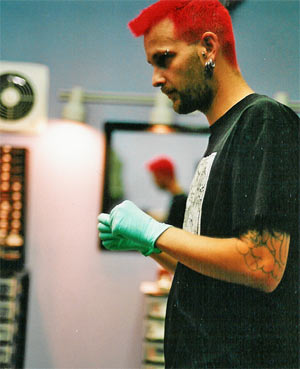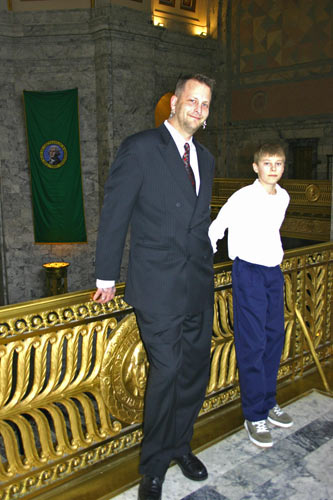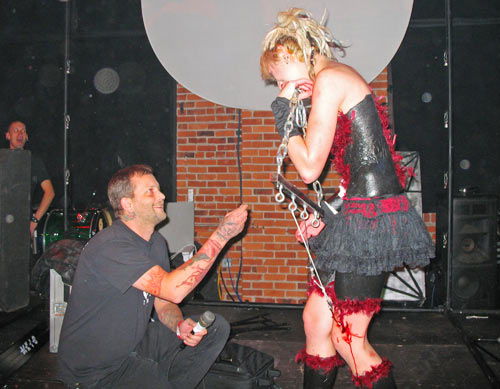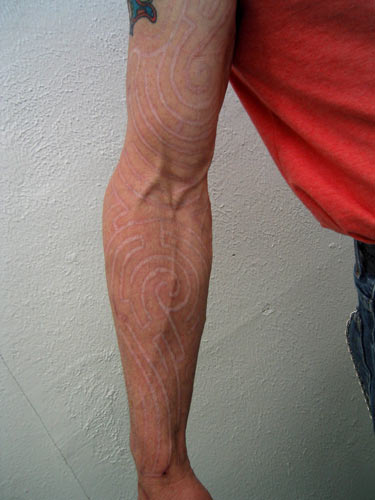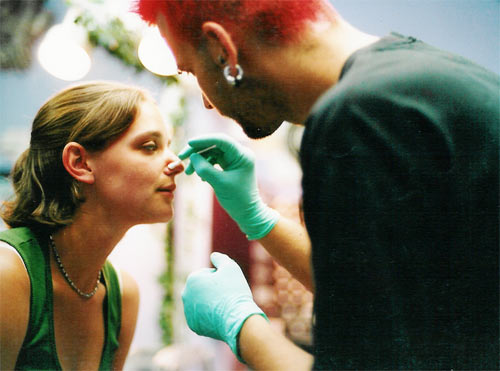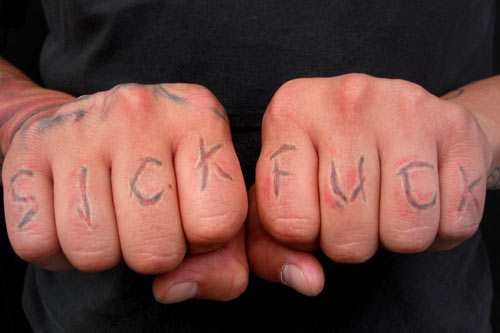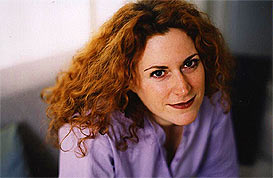
Troy Amundson is the perfect piercer poster person. A body modification artist for over seven years, he’s spent the last three lobbying for safe piercing in his state of Washington and also working to ensure that certain practices, such as those beloved on BME, are not banned. He’s been written about in the mainstream press numerous times as an unlikely lobbyist — unlikely in looks perhaps, but his effectiveness is undeniable. He’s kept body piercing bills on the front burner when some legislators claimed it was not a high-priority issue. Yet, the piercing bill is not the only thing on Troy’s plate. He’s working on the revision of the Seattle Municipal Code on Tattooing, and for a task like this, you want someone who knows and loves the art. He’s co-authored articles for medical journals on piercing practices, educating nurses and doctors as well as changing many of their attitudes towards those in our community. And he’s also one of those behind the MedPierce Kit, a body jewelry removal kit for healthcare facilities and correctional facilities. Troy’s a busy man. I spoke with Troy because his experiences inspire action. Moreover, he can teach us all techniques on how to fight for safe and fair body modification legislation and make a difference. MDM: First, I want to start by thanking you for your lobbying efforts to keep piercing safe in Washington state but also fighting to keep body art practices free from what I call “morality” legislation — laws passed not to protect the public but because legislators negatively view the outlawed practice, such as the proposed body art ban on Long Island, NYC that seeks to outlaw genital piercings and facial tattooing, among others. Have you always been politically active? TA: Thank you, I really appreciate the support. Encouraging words have definitely motivated me to keep going. I have rarely voted and have never attended a political rally. I was skeptical of the value of one citizen. I was disillusioned with what I saw as a corrupt and broken system. I never believed that one person could really make a difference. Take for example, our last presidential election. Regardless of partisanship, how many people were frustrated with the overall outcome? Counts, recounts, and court decisions. Followed by allegations of miscounts, fraud, and voter intimidation. Similar events recently affected Washington’s gubernatorial election. The power to reform the government is within our hands, not theirs.
Troy Amundson on Capitol Hill with his son MDM: Then I guess your view of government has changed. TA: 179°. I still have grave concerns over many issues that face society today. The major difference is that I have witnessed the power of a citizen’s voice. For many reasons, I believed I was an unlikely candidate to lobby. When I initially agreed to help with the project, I thought the lobbyists would want to keep me as far away from legislators as possible. Instead, the lobbyists decided to put me in front of as many legislators as possible. Under their guidance I learned how to play the game. I was under constant supervision the first year to avoid mistakes. All of my statements to legislators and the media were drafted and closely scrutinized. Now they find it amusing to watch me run rampant. MDM: Let’s go back. What prompted you to take action? TA: Opportunity and concern. A local public health official notified me that a concerned parent with connections and experience working in the capitol wanted to try to pass regulations for body piercing. Immediately, I recognized the implications that may have had on my beloved profession. There is nothing more fearsome than a mother protecting her young. Thankfully, due to an ongoing working relationship, the health official referred the woman to me.
Troy proposing to his financee from PURE Cirkus after the Pleasure 7 Pain show MDM: So what did you do? Can you describe your lobbying efforts and the political process? TA: I was fortunate enough to have the guidance of two professional lobbyists, one Democrat and one Republican. The Republican, Vito, is 81 and has become a fixture after dedicating over 40 years to working various jobs in the capitol. Vito has helped many people start careers in politics (including Democrats). His advice is widely respected and often sought by both parties. Regulations for body art procedures are a good public health issue due to the social popularity of these arts. It is also rare for any industry to step forward and request restrictive regulations. The issue has advanced meritoriously and by our pro-active position. The legislative session moves very fast. Legislators must brief themselves on hundreds of bills introduced in a session. They rely largely upon established relationships with others to determine their position on particular issues. For example, if I were a legislator, I would probably find public health issues the most interesting. While I may passionately research dozens of public health issues pending that session, there simply is not enough time to evaluate all the bills. Some issues, like the budget, would be extremely difficult for me to find any interest in. Unfortunately, my vote would ultimately be decided by facts provided by other legislators, capitol staff, lobbyists, and hopefully my constituents. As a lobbyist, or citizen lobbyist, you must spend time developing relationships with the legislators. In our case, we have developed very strong relationships with numerous legislators. For example, this year, legislators were faced with six bills to regulate body art. Through that earned trust, many legislators simply turned to my evaluation of the bills. We have maintained two goals in this effort:
A large part of our strategy relies on professional conduct, ethical lobbying, and a nonpartisan delivery of fact-based information. It is difficult to set aside personal feelings at times. There is no room for ego and nothing gets accomplished through partisan rhetoric.
Full sleeve branding by Troy Amundson MDM: What was it like testifying on behalf of piercing professionals before the state legislature? TA: This year I testified before various committees six times. I get nervous every time. I know that my words could sway opinion for, or against, our issue. No committee member likes it when a testimony drags on. Keep it short, make your points, and don’t waste time. Script everything and print it in an easy to read format. For body art issues, you probably have two to eight minutes to testify. Do not let too many people testify, perhaps two or three. If questioned, answer directly without too much extra information. The amount of time you are given will largely rely on the Chair or Vice Chair. I witnessed a notable difference in the treatment given to me opposed to the treatment of those supporting the morality bill. In committees where I had favor, I was allowed time to make my points. Most committee members listened intently to what I had to say. Our opposition was frequently challenged, interrupted, or simply cut short. If a bill is lobbied correctly, most of your work is done before the committee hearing. MDM: What kind of effect do you think your testimony had on the state legislature? TA: The demonstration of our willingness to work with legislators on body art related issues has been commended and continues to draw bipartisan support. We may not have passed a bill yet, but we have changed many opinions about the industry and body art in general. In one hearing, a doctor from Public Health Seattle & King County testified in support of one of our bills. I gave a brief testimony in support. The only question from the committee was directed to me. A “morality bill” that targets the industry, and not the protection of public health, has repeatedly threatened artists. Last year the bill passed the Senate. This year the bill died in committee, not even advancing to the Senate floor. This can only be credited to the continued education of the legislators on body art issues. Immediately after my testimony against the bill, five out of eight of the Labor & Commerce committee members signed as sponsors on our bill. Interestingly, the Chair of the committee sponsored the bad bill last year and our bill this year. After one of my testimonies, the sponsor of the “morality bill” screamed at me and accused me of lying to the committee. He has portrayed us as opposing his bill because we are trying to avoid oversight. He has repeatedly stated that without licensing, enforcement, and inspections, our bill only provides an “illusion” of regulations intentionally providing the public a false sense of security. It would be easy to cast me as opposed to licensing and inspection. It is becoming far more difficult for the supporters of the “morality bill” to make a logical argument. Where most legislators had no understanding of body art before, they are starting to recognize what is fact and what is not. Our persistence and pro-active approach does not reflect an industry trying to avoid oversight. Reviewing my testimonies and statements in the media, you would see that I support licensing and inspection. Legislators recognize that we are trying to take a positive step forward. With two exceptions, one minor and one major, I have received very professional treatment. Many of the legislators and lobbyists freely shared strategic advice with me. This year I was treated in the exact same manner as a professional lobbyist. Several of the lobbyists even claimed me as one of their own. Not one campaign donation has been made. I doubt any member of the Washington State Legislature will ever look at body art in the same way again. MDM: That’s fantastic! So what’s the status of the Bill? TA: Our bill is dead this year, but this is also the farthest that our issue has progressed. The Chair of the Labor & Commerce committee has stated the committee will be reviewing this issue during the interim. Thanks to invaluable established relationships, I foresee closed-door meetings in my near future. I am taking at least a year off. I will not be proactively lobbying for regulations next session, but I must make myself available to advise legislators on body art issues. MDM: In these efforts did you get a lot of help and support from the tattoo and piercing community? TA: Many artists have been extremely supportive, although many people do not know what they can do to help. Tattoo and piercing related issues can, and should, be widely supported by our clients as well. While public testimony should primarily be delivered by artists, there is no reason not to pack a hearing room with tattooed and pierced citizens. It is really hard for any committee member to ignore, especially when we tend to stick out from everyone else. High-visibility has become a significant advantage in our fight. Our issue would have benefited from more support. Emailing legislators and attending committee hearings become essential methods of support. Unfortunately the legislative session moves very fast. Even with close ties, I usually only had three to seven days notice between the time our bill was placed on an agenda and the time it was actually heard in committee. Many artists did not attend because of scheduling conflicts. No, it is not convenient. My commute to the capitol is about 65 miles (ranging from an hour to two and a half hours each way, one to four times per week) when working a bill. In addition to taking time off, I have incurred hundreds of dollars in gas expenses alone. Yet, it is extremely important to make time, especially when opposing legislation. I am sure most clients would understand and be supportive if the situation was explained. I strongly encourage shop owners to close for the day and make the event a shop outing. Encourage your clients to attend or offer to take them with you. It is disappointing to see artists take a day off after a night out drinking, but not when it really matters. The costs incurred individually far outweigh the costs of bad regulations. Clients can encourage their artist to get involved.
Troy piercing at Apocalypse Tattoo MDM: Beyond the Bill, you’ve also worked on the revision of the Seattle Municipal Code on Tattooing. How did you get involve in that and what changes did you advocate? TA: I have only recently begun working on a revision of the Seattle Municipal Code. I got involved the same way I became involved with the legislation, through having an established relationship with my local health department. I was invited to participate by both the City of Seattle and Public Health Seattle & King County. I have difficulty refusing such invitations. Many artists in the state have put aside personal and professional differences to support this cause. We will prepare a draft of the proposed new code, and then circulate it through shops for input. The process will take some time. The City of Seattle and Public Health Seattle & King County are very determined to hear input from the industry and develop a strong working relationship. One of the reasons for taking time off from lobbying is to focus more on the revision. MDM: And on top of all this you’ve also been active in educating the medical community on body piercing. Tell me about that. Has the medical community been receptive to what you have to teach them? TA: Body piercing motivated me to pursue training as an emergency medical technician. I teamed up with Scott DeBoer, a flight nurse from the University of Chicago Aeromedical Network. Scott’s specialities include flight, ER, and pediatric care. Scott had noted in his research that medical articles varied widely on body art issues and rarely included any perspective from artists. Scott lectures internationally, and objectively reviews health issues and medical concerns associated with body art. And bless his little Ned Flanders heart, he has become an advocate for body art. Ned now knows more about body art than many of his colleagues who have body art. I would also have to thank Elayne Angel and David Vidra. Often when I feel a question is out of my league, I have turned to their input. Many others have helped as well. Much of our research has been published.
Our research led to the subsequent design and production of a jewelry removal kit www.medpierce.com for licensed healthcare providers and correctional facilities. The kit was released in October 2006. While sales have initially been slow, the reviews have been very promising. MDM: This kit sounds like a great idea and much needed in the medical community. Through all this research and experience, you have a wealth of information to share with the piercing and tattoo community. What advice do you have on promoting safe body modification practices and also ensuring that certain practices are not banned? How can we best make our voices heard? TA: Learn the art of compromise and sometimes we must tone it down. Before anyone gets reactionary, let me clarify. Let’s take scarification for example. The very concept itself, artistic scars, is extreme for a large portion of the public. Originally, the lobbyists were extremely concerned how legislators would respond to words like brand, cut, or scalpel. Our priority became protecting the right of clients to have scarification and a right for the commercial application of scars as body art. One question that we did not try to address was what instruments were allowed to produce a scar. We simply stated that scarification should be regulated in a similar fashion to piercing. The procedures warrant the necessity of sterilization and hygiene requirements. Some states legally allow the use of scalpels, and other states do not. While I love scarification as an art, there is a justifiable concern over the use of certain implements. What is more important, our right to have beautiful scars, or the tools used to make them? Start small. Get involved. Start discussing issues with other artists/shops in your area. Put aside differences to support a greater cause. As frustrating as it may be at times, you always have to play it cool and professional. It is “us” against “them”. The only way to win is to have more of “us”. And not just artists, that includes everyone — legislators, public health officials, clients, the public, and the media. MDM: What’s next for you? Politics maybe? TA: I just want to pierce and burn people. Then nursing school. While legislators, clients, and friends have commented on the future of a political career, there may be too many skeletons in that closet. But one could argue that far worse criminals have been elected.
Copyright © 2007 Marisa Kakoulas. This online presentation copyright © 2007 BMEzine.com LLC. Requests to republish must be confirmed in writing. For bibliographical purposes this article was first published online April 18th, 2007 by BMEzine.com LLC in Toronto, Canada.
|
Post navigation
 BME/News and Modblog highlight only a small fraction of what BME has to offer. Take our free tour and subscribe to BME for access to over 3 million body modification related photos, videos, and stories.
BME/News and Modblog highlight only a small fraction of what BME has to offer. Take our free tour and subscribe to BME for access to over 3 million body modification related photos, videos, and stories.
